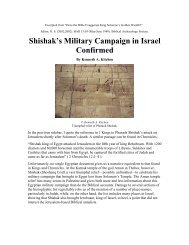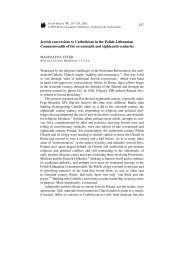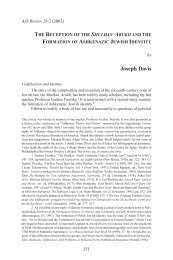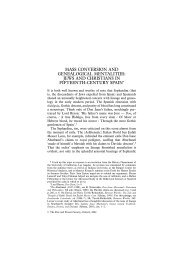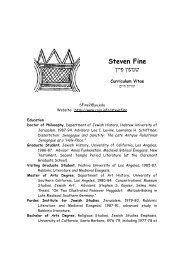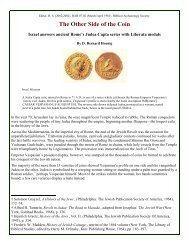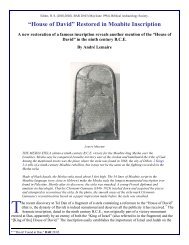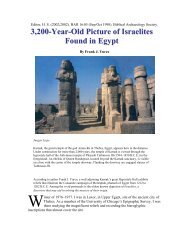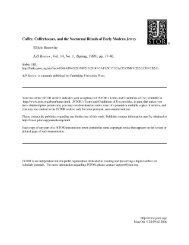Did the synagogue replace the temple? - cojs
Did the synagogue replace the temple? - cojs
Did the synagogue replace the temple? - cojs
Create successful ePaper yourself
Turn your PDF publications into a flip-book with our unique Google optimized e-Paper software.
Bible Review 12, no. 2 (1996).<br />
<strong>Did</strong> <strong>the</strong> Synagogue Replace <strong>the</strong> Temple?<br />
By Steven Fine<br />
In 70 C.E. Roman legions destroyed <strong>the</strong> Jerusalem Temple, Judaism’s holiest<br />
structure and <strong>the</strong> “dwelling place of God’s name.” Despite this loss, Judaism was<br />
to survive and prosper. In <strong>the</strong> following centuries, <strong>the</strong> <strong>synagogue</strong> itself came to<br />
be seen as a “holy place.”<br />
Does this mean, as some people suppose, that <strong>the</strong> <strong>synagogue</strong> as we know it<br />
developed after <strong>the</strong> destruction of <strong>the</strong> Temple and was, in fact, its <strong>replace</strong>ment?<br />
Not exactly. Communal meeting places that we can recognize as <strong>synagogue</strong>s<br />
existed while <strong>the</strong> Temple still stood, at least by <strong>the</strong> midfirst century B.C.E. The<br />
second part of <strong>the</strong> question—<strong>Did</strong> <strong>the</strong> <strong>synagogue</strong> <strong>replace</strong> <strong>the</strong> Temple?—is not so<br />
easily answered.<br />
The origins of <strong>the</strong> <strong>synagogue</strong> are shrouded in mystery, and scholarly opinions as<br />
to its beginnings vary. Some scholars trace its development to <strong>the</strong> First Temple<br />
period, o<strong>the</strong>rs to <strong>the</strong> Exile in Babylonia, and still o<strong>the</strong>rs (including <strong>the</strong> author) to<br />
<strong>the</strong> latter Second Temple period in Palestine. Virtually all scholars recognize that<br />
<strong>the</strong> <strong>synagogue</strong> was a welldeveloped institution at least a century before <strong>the</strong><br />
Romans destroyed <strong>the</strong> Temple. Synagogues in <strong>the</strong> Land of Israel are mentioned<br />
by <strong>the</strong> Jewish philosopher, exegete and communal leader Philo of Alexandria (c.<br />
20 B.C.E.40 C.E.); by <strong>the</strong> firstcentury C.E. Jewish historian Flavius Josephus;<br />
in <strong>the</strong> New Testament; and in rabbinic literature.<br />
Archaeology provides additional evidence for <strong>the</strong> early dating of <strong>the</strong> origins of <strong>the</strong><br />
<strong>synagogue</strong>. In 1913–1914, <strong>the</strong> French archaeologist Raymond Weill, exploring<br />
just south of <strong>the</strong> Temple Mount, found an ancient water cistern from which he<br />
recovered a Greek inscription describing <strong>the</strong> life of a <strong>synagogue</strong> community in<br />
<strong>the</strong> holy city while <strong>the</strong> Temple still stood:
Theodotus, son of Vettenos <strong>the</strong> priest and <strong>synagogue</strong> leader (archisynagogos),<br />
son of a <strong>synagogue</strong> leader and grandson of a <strong>synagogue</strong> leader, built <strong>the</strong><br />
<strong>synagogue</strong> for <strong>the</strong> reading of <strong>the</strong> Law (Torah) and studying of <strong>the</strong><br />
commandments, and as a hostel with chambers and water installations to<br />
provide for <strong>the</strong> needs of itinerants from abroad, which his fa<strong>the</strong>rs, <strong>the</strong> elders and<br />
Simonides founded. 1<br />
For <strong>the</strong> Greekspeaking Jews who frequented this Jerusalem <strong>synagogue</strong> during<br />
<strong>the</strong> late first century B.C.E. or <strong>the</strong> first century C.E., it was a place where <strong>the</strong>y<br />
could experience religion in a way very different from, yet complimentary to, what<br />
was available to <strong>the</strong>m in <strong>the</strong> Temple.<br />
Let’s imagine what it was like to make a pilgrimage to <strong>the</strong> Temple. To enter <strong>the</strong><br />
Jerusalem Temple a Jewish pilgrim would have had to purify him or herself<br />
through immersion in a ritual bath (miqveh)—perhaps even in <strong>the</strong> “water<br />
installations” mentioned in <strong>the</strong> Theodotus inscription. Toge<strong>the</strong>r with Jews from as<br />
far away as Spain, <strong>the</strong> Black Sea region and Persia, our pilgrim would have<br />
ascended to <strong>the</strong> great Temple of Herod, a short walk to <strong>the</strong> north, to participate in<br />
<strong>the</strong> public sacrifice and pageantry that were <strong>the</strong> hallmark of <strong>the</strong> Temple. Our<br />
pilgrim would have been a participantobserver in <strong>the</strong> Temple service. The rituals<br />
of <strong>the</strong> Temple were carried out by <strong>the</strong> priests and <strong>the</strong> Levites.<br />
The religious experience of <strong>the</strong> <strong>synagogue</strong> was quite different. In Hebrew, <strong>the</strong><br />
<strong>synagogue</strong> is called a beth haknesset, literally “house of assembly.” The Greek<br />
sunagoge means much <strong>the</strong> same thing. In Theodotus’s <strong>synagogue</strong>, located in<br />
<strong>the</strong> shadow of <strong>the</strong> Temple, <strong>the</strong> assembled community would have read Scripture<br />
and studied <strong>the</strong> commandments. As in <strong>synagogue</strong>s scattered throughout Israel<br />
and <strong>the</strong> Diaspora during this period, <strong>the</strong> central cultic activity in this Jerusalem<br />
<strong>synagogue</strong> was <strong>the</strong> reading and study of Scripture called ho nomos, “<strong>the</strong> Law” in<br />
<strong>the</strong> Greek of our inscription. At Masada, a desert fortress destroyed shortly after<br />
<strong>the</strong> Temple, biblical scrolls were found in close proximity to <strong>the</strong> <strong>synagogue</strong>—<br />
suggesting that <strong>the</strong> reading of Scripture was an important feature of <strong>synagogue</strong><br />
activity. Philo’s description of <strong>the</strong> <strong>synagogue</strong>s in Alexandria provides an insightful
parallel to <strong>the</strong> Theodotus inscription: “You sit in your groups [conventicles] and<br />
assemble your regular company and read in security your holy books,<br />
expounding any obscure point and in leisurely comfort discussing at length your<br />
ancestral philosophy.” 2<br />
An early rabbinic text reflects on how easily a Second Temple period Jew, such<br />
as our pilgrim, could move from Temple to <strong>synagogue</strong> and back again. This text<br />
describes <strong>the</strong> festival of Sukkot (Tabernacles), when <strong>the</strong> ceremony of <strong>the</strong> Water<br />
Drawing was performed at <strong>the</strong> Temple:<br />
Said Rabbi Joshua son of Hananiah: All <strong>the</strong> days of <strong>the</strong> celebration of <strong>the</strong> Water<br />
Drawing we never saw a moment of sleep. We would arise in time for <strong>the</strong><br />
morning daily wholeoffering [in <strong>the</strong> Temple].<br />
From <strong>the</strong>re we would go to <strong>the</strong> <strong>synagogue</strong>,<br />
From <strong>the</strong>re to <strong>the</strong> additional [mussaf]<br />
offering [in <strong>the</strong> Temple],<br />
From <strong>the</strong>re to eating and drinking,<br />
From <strong>the</strong>re to <strong>the</strong> study house,<br />
From <strong>the</strong>re to <strong>the</strong> Temple for <strong>the</strong> whole sacrifice at dusk,<br />
From <strong>the</strong>re to <strong>the</strong> celebration of <strong>the</strong> Water Drawing. 3<br />
Interestingly, Second Temple period sources do not mention <strong>synagogue</strong>s as<br />
places of prayer. This might come as a surprise to many who are accustomed to<br />
a modern <strong>synagogue</strong>. Evidently, ei<strong>the</strong>r prayer did not take place in <strong>synagogue</strong>s<br />
at this time or <strong>the</strong> role of prayer in <strong>synagogue</strong> life was dwarfed by <strong>the</strong> study of<br />
Scripture.<br />
While <strong>the</strong> Temple still stood, a new kind of religious experience developed within<br />
<strong>the</strong> <strong>synagogue</strong> that paralleled <strong>the</strong> ageold cult of <strong>the</strong> Temple. Local communities<br />
came toge<strong>the</strong>r in <strong>synagogue</strong>s to encounter <strong>the</strong> divine in <strong>the</strong> intimate fellowship of<br />
likeminded Jews. Those Jews who assembled or perhaps lodged in Theodotus’s<br />
<strong>synagogue</strong> could move almost effortlessly from communal Torah study to <strong>the</strong><br />
offering of sacrifices at <strong>the</strong> Temple, with no sense that <strong>the</strong>se institutions were in<br />
any way in competition for <strong>the</strong>ir loyalty.
Still, <strong>the</strong> <strong>synagogue</strong> did represent a new approach to Judaism, one that was<br />
closely related in form to <strong>the</strong> GrecoRoman collegea. In <strong>the</strong> Land of Israel, this<br />
change appears to have occurred after <strong>the</strong> conquest of Palestine in 332 B.C.E.<br />
by Alexander <strong>the</strong> Great, and perhaps even after <strong>the</strong> Maccabean Revolt of 168–<br />
164 B.C.E. Like adherents of o<strong>the</strong>r religions, Jews in GrecoRoman Palestine<br />
assembled in selfdefined communities where <strong>the</strong>y developed religious practices<br />
that were more intimate than those of <strong>the</strong> great civic religion of <strong>the</strong> Jerusalem<br />
Temple.<br />
The Temple was regarded as <strong>the</strong> center of <strong>the</strong> universe, <strong>the</strong> navel of <strong>the</strong> world—<br />
what <strong>the</strong> great historian of religion Mircea Eliade called <strong>the</strong> axis mundi between<br />
<strong>the</strong> sacred and <strong>the</strong> profane. Synagogues, on <strong>the</strong> o<strong>the</strong>r hand, were local places<br />
where Jews came toge<strong>the</strong>r to study Scripture, through which <strong>the</strong>y gained access<br />
to <strong>the</strong> revealed word of God. While <strong>the</strong> Temple still stood, <strong>the</strong> <strong>synagogue</strong> was a<br />
complementary, not a competitive, institution.
What of <strong>the</strong> period after <strong>the</strong> destruction of <strong>the</strong> Temple? <strong>Did</strong> <strong>the</strong> <strong>synagogue</strong> <strong>the</strong>n<br />
<strong>replace</strong> <strong>the</strong> Temple?<br />
No doubt <strong>the</strong> destruction of Herod’s Temple created an unparalleled religious<br />
challenge. Not since <strong>the</strong> destruction of Solomon’s Temple in 586 B.C.E. had<br />
Jewish communities faced such a religious trauma. The early rabbinic sages (<strong>the</strong><br />
Tannaim) met this challenge by stressing those elements of Judaism that had<br />
survived <strong>the</strong> destruction of <strong>the</strong> Temple. For example, <strong>the</strong> teaching aspect of <strong>the</strong><br />
Passover meal (<strong>the</strong> Seder) was emphasized, and <strong>the</strong> Pascal sacrifice, which was<br />
<strong>the</strong> focal point of <strong>the</strong> Passover evening in Second Temple times, was played<br />
down.<br />
Similarly, Torah study, ra<strong>the</strong>r than <strong>the</strong> Temple service, became <strong>the</strong> most<br />
important religious act of <strong>the</strong> Jew; study was seen as <strong>the</strong> essential vehicle for<br />
knowing God’s will. The <strong>synagogue</strong>, <strong>the</strong> focal point for communal study, thus<br />
took on added significance. This “house of assembly” became <strong>the</strong> institutional<br />
focal point for <strong>the</strong> tannaitic reconstruction of Judaism.<br />
Slowly, <strong>the</strong> religious significance of <strong>the</strong> <strong>synagogue</strong> expanded. The meeting<br />
house of <strong>the</strong> Second Temple period was gradually transformed over <strong>the</strong> coming<br />
centuries into a holy place, though contemporaneous Jews never explicitly<br />
thought of it as a <strong>replace</strong>ment of <strong>the</strong> lost Temple.
Synagogues were associated with <strong>the</strong> Temple in numerous early rabbinic<br />
sources. Biblical verses referring to <strong>the</strong> Temple were read as including<br />
<strong>synagogue</strong>s. For example, in Leviticus 26:31, “I will destroy your <strong>temple</strong>s<br />
[miqdasheihem],” <strong>the</strong> word “<strong>temple</strong>s” was interpreted by <strong>the</strong> sages to include<br />
<strong>synagogue</strong>s and study houses [batei midrash] in God’s eternal plan. 4 The<br />
<strong>synagogue</strong> was thus incorporated into sacred time.<br />
The <strong>synagogue</strong>’s relationship to <strong>the</strong> Temple was sometimes suggested in subtle<br />
ways in early rabbinic sources. For example, <strong>the</strong> sages decreed that a<br />
<strong>synagogue</strong> destroyed by no fault of <strong>the</strong> community should be treated with<br />
respect—a parallel of <strong>the</strong> respect demanded for <strong>the</strong> nowdestroyed Temple<br />
Mount. The sages deemed it inappropriate to use <strong>the</strong> ruins of <strong>synagogue</strong>s as<br />
shortcuts, because <strong>synagogue</strong>s “remain sacred even when <strong>the</strong>y are destroyed.” 5<br />
Beginning with <strong>the</strong> Tannaim of <strong>the</strong> late first and second centuries C.E.,<br />
<strong>synagogue</strong>s were no longer exclusively places of study; <strong>the</strong>y became places of<br />
prayer as well. Prayer was instituted as a thricedaily regime corresponding to<br />
<strong>the</strong> times sacrifices had been offered in <strong>the</strong> Temple.<br />
The central prayer of <strong>the</strong> rabbinic liturgy, today called <strong>the</strong> Amidah, was recited<br />
facing Jerusalem—a reflection of <strong>the</strong> continuing centrality of <strong>the</strong> Temple in<br />
Jewish life. Similarly, one tradition suggests that <strong>the</strong> Torah cabinet was set on<br />
<strong>the</strong> wall opposite <strong>the</strong> holy city, aligned toward <strong>the</strong> Temple of God. a
Just as <strong>the</strong> Temple was <strong>the</strong> divine residence, so prayer brought <strong>the</strong> divine<br />
presence to <strong>the</strong> <strong>synagogue</strong>: “Whenever ten people congregate in <strong>the</strong> <strong>synagogue</strong><br />
<strong>the</strong> divine presence is with <strong>the</strong>m.” 6 By <strong>the</strong> third century, some sages held that <strong>the</strong><br />
status of <strong>synagogue</strong> prayer was so great that, according to <strong>the</strong> Jerusalem<br />
Talmud, “He who prays in <strong>the</strong> <strong>synagogue</strong> is like one who sacrifices a pure meal<br />
offering [minhah].” 7<br />
The rabbinic sages also drew on Temple imagery in referring to <strong>the</strong> <strong>synagogue</strong>,<br />
but only in a provisional way. Synagogues were but pale reflections of <strong>the</strong><br />
Jerusalem Temple; <strong>the</strong>y were not in direct competition with it. The real danger<br />
was that <strong>synagogue</strong>s might become alternatives to <strong>the</strong> Temple in <strong>the</strong> wake of its<br />
destruction. Alternative <strong>temple</strong>s existed even during <strong>the</strong> latter Second Temple<br />
period—at Heliopolis in Egypt, in Samaria and perhaps at Beth El. To ensure <strong>the</strong><br />
distinctive character of <strong>the</strong> Temple, some early sources warned that nei<strong>the</strong>r<br />
sevenbranched menorahs like those of <strong>the</strong> Temple nor cherubim (which rested<br />
above <strong>the</strong> Ark of <strong>the</strong> Covenant in Solomon’s Temple) should be set up in<br />
<strong>synagogue</strong>s. A complementary relationship between <strong>the</strong> Temple and<br />
<strong>synagogue</strong>s was constructed by emphasizing <strong>the</strong> sanctity of <strong>synagogue</strong>s as<br />
places of Torah, while expressing this sanctity in forms reminiscent of <strong>the</strong> more<br />
deeply sacred Temple. As time passed and <strong>the</strong> memory of <strong>the</strong> Temple became<br />
more distant, <strong>the</strong> <strong>synagogue</strong> began to be called a “holy place,” a “holy house”<br />
and even a “small <strong>temple</strong>.” 8<br />
A similar development can be seen in <strong>the</strong> chest that housed <strong>the</strong> Torah and o<strong>the</strong>r<br />
biblical books in <strong>the</strong> <strong>synagogue</strong>. In early rabbinic (tannaitic) literature, it is called<br />
a teva. In <strong>the</strong> Bible, <strong>the</strong> box in which <strong>the</strong> infant Moses floats down <strong>the</strong> Nile is a<br />
teva. By <strong>the</strong> second century C.E., however, “teva” refers to chests used for many<br />
different purposes. In <strong>the</strong> succeeding centuries, <strong>the</strong> Torah chest is called an<br />
arona, Aramaic for “ark.” In a dedicatory inscription found in an ancient
<strong>synagogue</strong> in Naveh (modern Nawa, in Syria), a dedicatory inscription calls <strong>the</strong><br />
Torah shrine a beit arona, literally “house of <strong>the</strong> ark.” 9 In <strong>the</strong> Bible, <strong>the</strong> Ark of <strong>the</strong><br />
Covenant, which was <strong>the</strong> centerpiece of <strong>the</strong> Tabernacle and Solomon’s Temple,<br />
is <strong>the</strong> aron haberit, or “ark of <strong>the</strong> covenant.” According to literary sources and<br />
artistic representations of Torah arks, <strong>the</strong> <strong>synagogue</strong> Torah chest was a tall<br />
cabinet, sometimes, according to one text, divided into upper and lower sections.<br />
The scrolls were laid on shelves in <strong>the</strong> cabinet, in <strong>the</strong> way that scrolls were<br />
generally stored in <strong>the</strong> GrecoRoman world. 10 The Torah ark sometimes had a<br />
curtain in front of it, called a vilon or parokhta. Some connected this curtain with<br />
<strong>the</strong> parokhet that separated <strong>the</strong> Holy of Holies from <strong>the</strong> main hall of <strong>the</strong> Temple.<br />
In one ancient source, a rabbi made <strong>the</strong> connection between <strong>the</strong> Torah ark in <strong>the</strong><br />
<strong>synagogue</strong> and <strong>the</strong> Ark of <strong>the</strong> Covenant in <strong>the</strong> Temple quite explicitly. On a fast<br />
day, Rabbi Huna <strong>the</strong> Greater of Sepphoris lamented that <strong>the</strong> assembled<br />
community covered <strong>the</strong> Torah ark with ashes as a sign of mourning, as <strong>the</strong>ir<br />
forefa<strong>the</strong>rs had covered <strong>the</strong> Ark of <strong>the</strong> Covenant with gold. 11<br />
On <strong>the</strong> o<strong>the</strong>r hand, <strong>the</strong> rabbis were careful not to confuse <strong>the</strong> Torah ark with <strong>the</strong><br />
Temple Ark. According to some traditions, <strong>the</strong> Ark of <strong>the</strong> Covenant would be<br />
restored to <strong>the</strong> Temple during messianic times. The Torah shrine, by contrast,<br />
like <strong>the</strong> <strong>synagogue</strong> itself, could be sold as a commodity. The Torah ark was a<br />
holy object in <strong>the</strong> <strong>synagogue</strong>, an institution whose sacredness was thisworld<br />
bound—pale in comparison to <strong>the</strong> eternally sacred “House of God.”<br />
As time progressed, more and more behaviors and images reminiscent of <strong>the</strong><br />
Temple were applied to <strong>synagogue</strong>s. One particularly interesting text comes from<br />
<strong>the</strong> famous genizah of <strong>the</strong> Ben Ezra <strong>synagogue</strong> in Cairo, b which housed<br />
documents that, though copied during <strong>the</strong> middle ages, preserve texts dating to<br />
<strong>the</strong> Byzantine and even <strong>the</strong> Roman periods. In this text, <strong>synagogue</strong> worshipers<br />
are admonished to wash <strong>the</strong>ir hands and feet before entering, and <strong>the</strong><br />
<strong>synagogue</strong> itself is referred to as a “small <strong>temple</strong>”:<br />
The sages said: “One shall not enter <strong>the</strong> Temple Mount with his staff and shoes”<br />
[Mishnah Berakhot 9.5]. Though by our sins <strong>the</strong> Temple Mount is not ours, we do<br />
have <strong>the</strong> “small <strong>temple</strong> [<strong>the</strong> <strong>synagogue</strong>],” and we are obligated to behave [toward<br />
it] with sanctity and awe. For it is written: “My <strong>temple</strong>, fear” [Leviticus 19:30, 26:2<br />
]. Therefore <strong>the</strong> ancients decreed in all <strong>synagogue</strong> courtyards that lavers of living<br />
water for <strong>the</strong> sanctification of <strong>the</strong> hands and feet [be set up]. 12<br />
A water installation that may have been used for hand and foot washing was<br />
found just inside <strong>the</strong> entrance to <strong>the</strong> sixthcentury <strong>synagogue</strong> excavated at Ein<br />
Gedi, on <strong>the</strong> shore of <strong>the</strong> Dead Sea. Washing <strong>the</strong> hands and feet and entering<br />
holy places barefooted were common religious practices in late antiquity, as <strong>the</strong>y<br />
are today in Islam. Hand washing when entering a <strong>synagogue</strong> is still practiced by<br />
some Jews.
Yet, architecturally, no <strong>synagogue</strong> looked anything like <strong>the</strong> Temple. Remains of<br />
over a hundred <strong>synagogue</strong> buildings from <strong>the</strong> third to <strong>the</strong> eighth centuries C.E.<br />
have been uncovered in <strong>the</strong> Land of Israel. The Temple built by Herod was a<br />
massive structure that integrated biblical and early Second Temple period<br />
traditions with <strong>the</strong> architectural traditions of imperial Rome. Synagogue<br />
architecture, on <strong>the</strong> o<strong>the</strong>r hand, had more in common with <strong>the</strong> public basilicas<br />
and churches of <strong>the</strong> late Roman and Byzantine periods than with <strong>the</strong> Temple.<br />
The <strong>synagogue</strong>s that have been excavated were mostly large, roofed halls<br />
designed to accommodate worshipers who ga<strong>the</strong>red in <strong>the</strong>m for public ritual. The<br />
Temple shrine was not meant for <strong>the</strong> public. The pious assembled faithfully on<br />
<strong>the</strong> Temple Mount platform and in <strong>the</strong> porticoes that surrounded <strong>the</strong> shrine.<br />
Three basic architectural plans were used in <strong>synagogue</strong>s. The broadhouse type,<br />
a large meeting house with a podium supporting a Torah shrine on its wide,<br />
Jerusalemfacing wall, is known from Khirbet Shema in <strong>the</strong> upper Galilee and<br />
from <strong>the</strong> Judean hill country south of Hebron. The “Galilean Basilica” developed<br />
in <strong>the</strong> area north of <strong>the</strong> Sea of Galilee. This type is best known from <strong>the</strong><br />
<strong>synagogue</strong>s of Capernaum and Bar’am. The facades of <strong>the</strong>se <strong>synagogue</strong>s faced<br />
Jerusalem and had three large portals. These buildings bear a striking<br />
resemblance to Christian church architecture in Syria. The third group,<br />
characterized by a longhouse basilica with an apse at one end, is found in <strong>the</strong><br />
Jordan Rift valley, lower Galilee and <strong>the</strong> coastal plain. In longhouse basilicas, a<br />
podium with a Torah shrine standing on it was built opposite <strong>the</strong> entrance, on <strong>the</strong>
wall aligned with Jerusalem. The arrangement of <strong>the</strong> apsidal basilica was taken<br />
over directly from Christian church architecture.<br />
What unites all of <strong>the</strong>se buildings is <strong>the</strong>ir focus on <strong>the</strong> community, <strong>the</strong> fact that<br />
most were oriented toward Jerusalem and that most had large Torah shrines.<br />
A number of <strong>synagogue</strong>s, especially of <strong>the</strong> third type, were paved with mosaics<br />
that depicted <strong>the</strong> Torah ark. One especially famous example is from <strong>the</strong><br />
<strong>synagogue</strong> at Beth Alpha; similar depictions have been found in mosaic<br />
<strong>synagogue</strong> floors at Hammath Tiberias (fourth century), Naaran (fifthsixth<br />
centuries) and BethShean (sixth century). In <strong>the</strong> <strong>synagogue</strong>s at Beth Alpha,<br />
Naaran and BethShean, <strong>the</strong> mosaic panel was laid before <strong>the</strong> apse. The Torah<br />
shrine on <strong>the</strong> mosaic floor of <strong>the</strong> <strong>synagogue</strong> at Beth Alpha is topped by two birds<br />
and flanked by two sevenbranched menorahs and two rampant lions.<br />
Scholars have long debated what is represented in this mosaic panel. Some,<br />
including Eleazar L. Sukenik, who excavated Beth Alpha in <strong>the</strong> late 1920s,<br />
believe it is a reflection of <strong>the</strong> actual furnishings of <strong>the</strong> Beth Alpha <strong>synagogue</strong><br />
apse. This is certainly right. All of <strong>the</strong> elements illustrated have been recovered in<br />
<strong>synagogue</strong> excavations. A similar Torah shrine pediment was discovered by Eric<br />
M. Meyers and Carol Meyers in a <strong>synagogue</strong> at Nabratein. Large stone<br />
menorahs were found in <strong>synagogue</strong>s at Hammath Tiberias and Maon, in Judea.
A large lion was discovered at Chorazin, and cloth curtains like<strong>the</strong> one<br />
represented in <strong>the</strong> mosaic from BethShean are mentioned in rabbinic literature.<br />
So what is <strong>the</strong> answer to our original question? <strong>Did</strong> <strong>the</strong> <strong>synagogue</strong> in Palestine of<br />
late antiquity <strong>replace</strong> <strong>the</strong> Temple? Ano<strong>the</strong>r text from <strong>the</strong> Cairo Genizah relates<br />
that “as long as <strong>the</strong> Temple existed, perpetual sacrifices and offerings would<br />
atone for <strong>the</strong> sins of Israel. Now <strong>synagogue</strong>s are unto Israel in place of <strong>the</strong><br />
Temple. As long as Israel prays in <strong>the</strong>m, <strong>the</strong>ir prayers are in place of <strong>the</strong><br />
perpetual sacrifices and offerings.” 13<br />
This seems like a genuine doctrine of “<strong>replace</strong>ment.” The text, however, still sets<br />
<strong>the</strong> Temple as <strong>the</strong> standard of true religion, as <strong>the</strong> source of “atonement” in <strong>the</strong><br />
ideal world. If <strong>synagogue</strong> ritual is conducted properly, <strong>the</strong> tradition argues, we<br />
“will see <strong>the</strong> rebuilding of <strong>the</strong> Temple and [<strong>the</strong> reestablishment of] <strong>the</strong> perpetual<br />
sacrifices and offerings.” 14 Within <strong>the</strong> <strong>synagogue</strong>, <strong>the</strong> centrality of Torah study<br />
and prayer remained a constant. Even in <strong>the</strong> Cairo Genizah text, which contains<br />
<strong>the</strong> only explicit statement of <strong>replace</strong>ment that I know of, <strong>the</strong> <strong>replace</strong>ment is<br />
provisional. As long as <strong>the</strong> Temple is in ruins, <strong>the</strong> text tells us, <strong>the</strong> only sure way<br />
of communing with <strong>the</strong> divine is through <strong>synagogue</strong> prayer. The passage quoted<br />
above continues:<br />
[By reciting] prayers at <strong>the</strong>ir proper time and directing <strong>the</strong>ir hearts, <strong>the</strong>y [will] merit<br />
and will see <strong>the</strong> rebuilding of <strong>the</strong> Temple and [<strong>the</strong> reestablishment of] <strong>the</strong><br />
perpetual sacrifices and offerings, as it is said: “And I will bring <strong>the</strong>m to my holy<br />
mountain and I will rejoice in my house of prayer” [Isaiah 56:7]. Their sacrifices<br />
and offerings will be received well on my altar, “for my house shall be called a<br />
house of prayer for all of <strong>the</strong> nations.<br />
Citing <strong>the</strong> prophet Isaiah, this writer refers to <strong>the</strong> Temple as a “house of prayer.”<br />
The homilist of this tradition chose to emphasize this verse precisely because it<br />
serves as a bridge between <strong>the</strong> <strong>synagogue</strong> as a current house of prayer and <strong>the</strong><br />
Temple as <strong>the</strong> eternal house of prayer.<br />
The answer to our question is complex. At no time was <strong>the</strong> <strong>synagogue</strong> a serious<br />
threat to <strong>the</strong> centrality and sanctity of <strong>the</strong> Temple. In <strong>the</strong> centuries after 70 C.E.,<br />
as hopes for <strong>the</strong> Temple’s imminent rebuilding dimmed, <strong>the</strong> <strong>synagogue</strong> as an<br />
institution blossomed and became, in itself, a Sacred Realm.<br />
For Jews, <strong>the</strong> <strong>synagogue</strong> became <strong>the</strong> bridge between <strong>the</strong> loss of <strong>the</strong>ir cosmic<br />
center and <strong>the</strong> hope for <strong>the</strong> rebuilding of <strong>the</strong> Temple. In <strong>the</strong> <strong>synagogue</strong>, <strong>the</strong>y<br />
concentrated <strong>the</strong>ir religious hopes, praying, in <strong>the</strong> words of an ancient sage, that<br />
“<strong>the</strong> Temple [be] rebuilt, speedily in our day.”



